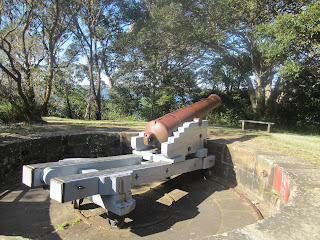.
 |
| Third Settlement Reserve |
 |
| View across Third Settlement Reserve looking west. |
"Toon-gab-be'' as it was then known was the Third Settlement in the Colony (after Sydeny Cove and Parramatta) and the site of the Government Farm established by Governor Phillip in 1791.
Under the direction of Superintendant Thomas Daveney, Phillip's aim was to open up more agricultural land for the Colony after the arrival of the Second Fleet. By 1792 it has become the principal farm of the Colony with approximately 696 acres (281.6 hectacres) being sown with wheat, maize and barley. Some 500 convicts, mainly from the Third Fleet, were assigned to the Farm. Conditions under Daveney were harsh. Toongabbie was the first place of secondary punishment in the Colony. Also most of the Irish convicts transportedbetween 1797 and 1801 were sent there.
The actual site of the convict township which existed between 1791-1803 was on the western bank of Toongabbie Creek between what is today Old Windsor and Oakes Roads in Old Toongabbie - site of Baxter Healthcare and the Endeavour Energy Substation.
The extent of the actual farming land is probably a matter of conjecture, but signage in Third Settlement Reserve states "Today's Junction and Gibbon Roads were originally the 'Toongabbee Road' which followed the northern boundary of the Government Farm". This would place the areas under cultivation on the northern banks of the Creek in the present day Winston Hills.
The NSW Government Office of Environment and Heritage has prepared a Toongabbie Government Farm Archaeological Site Draft (June 2012) which has very valuable information on the site.
There is very little above ground evidence remaining of the Government Farm site today. But we did locate a set of seven sandstone steps cut into the bedrock of Toongabbie Creek at the northern end of its north-south reach, on the eastern side, just off Goliath Avenue, Winston Hills.
The first four steps are shallow with pecked surfaces that are consistent with the work of convict labourers. The above three steps are likely to be be of later origin, probably the work of George Oakes in the 1860s in connection with the construction of the nearby weir across the Creek to provide a private swimming pool for his residence.
 |
| View of Sandstone Steps leading down to Toongabbie Creek, looking east from Settlers Walk. |
 |
| Evidence of convict pick marks in the sandstone steps. |
 |
| View across Toongabbie Creek looking south-west to Oakes Reserve. |
History Services NSW in its Convict Database, has detailed records of 115 convicts who were either assigned to, or settled in the Toongabbie area, including:
- William JOYCE per Abermarle, arriving in Port Jackson on 13 October 1791 from Portsmouth (Third Fleet). Granted land at Toongabbie in 1794. Married Sarah Jackson per Brittania on 19 August 1799 at St Johns, Parramatta. In 1804 he rode to Parramatta to warn authorities that the convicts had rebelled at Castle Hill;
- John PYE per Brittania arriving in Port Jackson on 14 October 1791 from Portsmouth (Third Fleet). Married Mary Phillips per Mary Ann on 11 December 1791 at St Johns, Parramatta. Granted land in 1796 and settled at Toongabbie;
- Kennedy MURRAY per Pitt arriving in Port Jackson on 14 February 1972 from Yarmouth Rds. Initially assigned to the Toongabbie Convict Farm. In 1796 he was sent to Norfolk Island.
- Bryan (Berny) REILLY per Boddingtons arriving in Port Jackson on 7 August 1793 from Cork. Granted land at Toongabbie in December 1799. In 1804, he took part in the Battle at Castle Hill and was sentenced to receive as many lashes as he could stand.
If you are interested in researching a convict ancestor from the Toongabbie area, go to our website at :
*********************************************************************************
Blog prepared by Mary McGuinness. All photos taken September 2012










